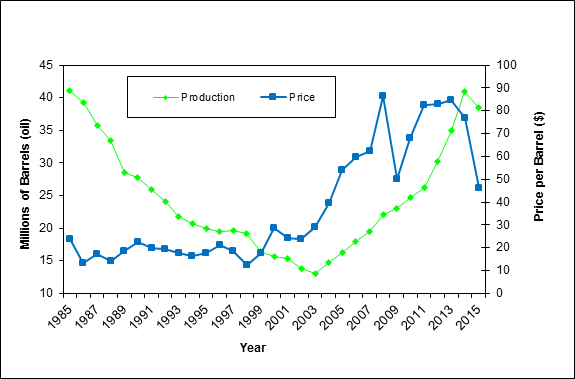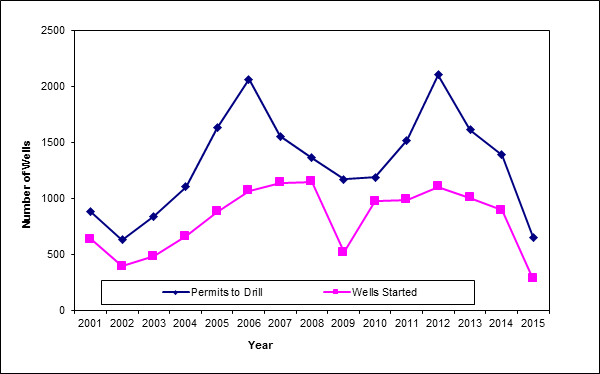Energy News: Some Impacts of Low Oil Prices on Utah
by David E. Tabet
For the past year or so Utah drivers may have been enjoying low gasoline prices at the pump as a result of the dramatically lower price paid per barrel of oil (1 barrel = 42 gallons) which came about when Saudi Arabia increased production and drove down oil prices. While the average driver and the transportation sector of the Utah economy may be benefiting from lower oil prices, those benefits are coming at the expense of the oil producing sector, whose revenues and profits have fallen. Utah, as the 11th largest oil producing state in the U.S., will have some negative impacts to its economy as a result of the current low prices paid per barrel of oil.

Utah average annual oil price per barrel and production from 1985 through 2015 (2015 full-year data are estimated). Sources: UGS files and Utah Division of Oil, Gas and Mining.
Because oil is an internationally traded commodity, Utah oil prices are affected by changes in the world market. Utah oil prices have dropped from about $86 per barrel in July 2014 to about $33 per barrel in January 2015. Over the past 30 years, the trend of Utah’s oil prices has fluctuated, trading in a mostly flat range from 1985 to 1998, and since 1999 on a generally upward, but volatile, trend. Besides the 40 percent drop in the average annual oil price per barrel in 2015, there have only been three other times in the past 30 years when the average annual oil price has dropped by more than 30 percent from the previous year: 1986 (44 percent drop), 1998 (32 percent drop), and 2009 (42 percent drop) when there was a major economic recession. The 2015 drop in Utah’s average annual oil price harkens back to the 44 percent oil price drop in 1986 when, like today, Saudi Arabia sought to regain market share by increasing production to lower prices and drive higher-cost suppliers, such as those in Utah with difficult-to-handle waxy crude, from the market.
Although full-year numbers are not yet in for 2015, it appears that Utah, as one of the higher-cost petroleum-producing states, will see its oil production fall from 40.9 million barrels in 2014 to 38.5 million barrels in 2015, or about a 6 percent decrease. This production decline will result from a dramatic drop in drilling activity in the state. The annual rig count for Utah is forecast to plunge from an average of 25 operating rigs in 2014 to a projected annual average of about 8 rigs for 2015. In a similar fashion, applications to drill and well starts (spuds) for 2015 in Utah are expected to be at low levels not seen since 2002.
Economically, this recent decline in petroleum exploration and production activities significantly affects the gross value of Utah’s produced oil and gas. The value of oil and gas production is anticipated to drop from $5.6 billion in 2014 to about $3.0 billion in 2015. The decrease in petroleum exploration and production activity over a year’s period ending March 2015 led to a loss of 791 energy-related jobs in Duchesne and Uintah Counties according to recently released statistics from the Utah Department of Workforce Services, and petroleum development activity in Utah has decreased further since that time.

Annual permits to drill and wells started (spudded) from 2001 through 2015 (2015 full-year data are estimated). Source: Utah Division of Oil, Gas and Mining.
In addition to lower income tax revenues from laid-off petroleum and service-company workers, Utah’s general fund will likely lose about $38 million in severance tax revenue related to oil and gas, since these taxes are estimated to decline from over $89 million in 2014 to about $51 million in 2015. The State of Utah will also see its 48 percent share of oil and gas royalties from petroleum production on federal lands in Utah shrink by another $50 million. The royalties collected for energy production from federal lands in Utah by the U.S. Office of Natural Resources Revenue and returned to the state will decrease from over $167 million in 2014 to an estimated $116 million for 2015. The State of Utah also collects a 0.2 percent conservation fee on the net production value of oil and gas produced from state and private lands to help with public education about oil and gas and to plug orphaned and abandoned petroleum wells. In 2014 about 20.4 million barrels of oil and 177.6 billion cubic feet of natural gas were produced from state and fee lands with an estimated value of $2.5 billion that would generate about $5 million for the conservation fund. For 2015, the conservation fee collections will likely be reduced 40 percent to about $3 million.
This reduction of over $85 million in petroleum-related revenue to the State of Utah from 2014 to 2015 only amounts to a 1.3 percent drop in overall state revenue, but certain parts of state government and several county governments will be more severely affected than others. Since it is difficult to predict when oil prices and industry activity will pick up in the future, these impacts could continue for several more years. At present, many financial forecasters are predicting a slow, gradual increase in oil prices through 2016 to an average annual price of about $50 per barrel from around $46 per barrel in 2015. Hopefully growth in other sectors of Utah’s economy will benefit from lower oil prices and offset losses in revenue and employment in Utah’s petroleum sector that have been caused by the plunge in oil prices, activity, and ultimately production.








